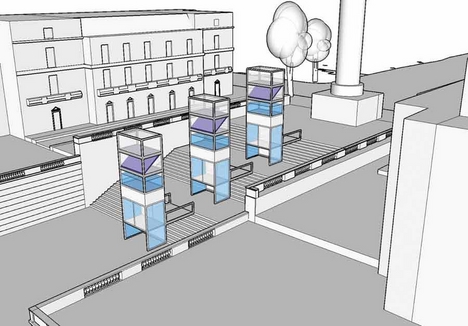- The Interlock House was a recent entry in the Solar Decathlon in DC (via Urbantrekker). Designed by a team from Iowa State, the house "is designed specifically to appeal to seniors and meets all regulations for accessibility under the 1990 Americans with Disabilities Act. The house is also designed to "interlock" into existing communities instead of taking over undeveloped land—a much more sustainable approach to building." (nice way of putting the joint goals of universal design and sustainability)

Image: Computer drawing of the Interlock House, a modern, rectangular house with an angled roof covered in solar panels and surrounded by a yard and blooming garden. A wide, flat deck that wraps around the corner. In the mock-up, an older couple go about their daily tasks: she is arriving with a bag in hand, he is raking leaves.
- Temporary solar-powered wheelchair lifts are to be installed at the Duke of York steps in London for the Festival of Architecture next year (via bd). Cool solution for the age-old historic buildings accessibility problem, and fitting modern look for the festival. Reminds me of my old post on a world without stairs.
 Image: Computer drawing of the three-tiered Duke of York steps, with the mock-ups of three glass towers installed on the landings to house wheelchair lifts.
Image: Computer drawing of the three-tiered Duke of York steps, with the mock-ups of three glass towers installed on the landings to house wheelchair lifts.

